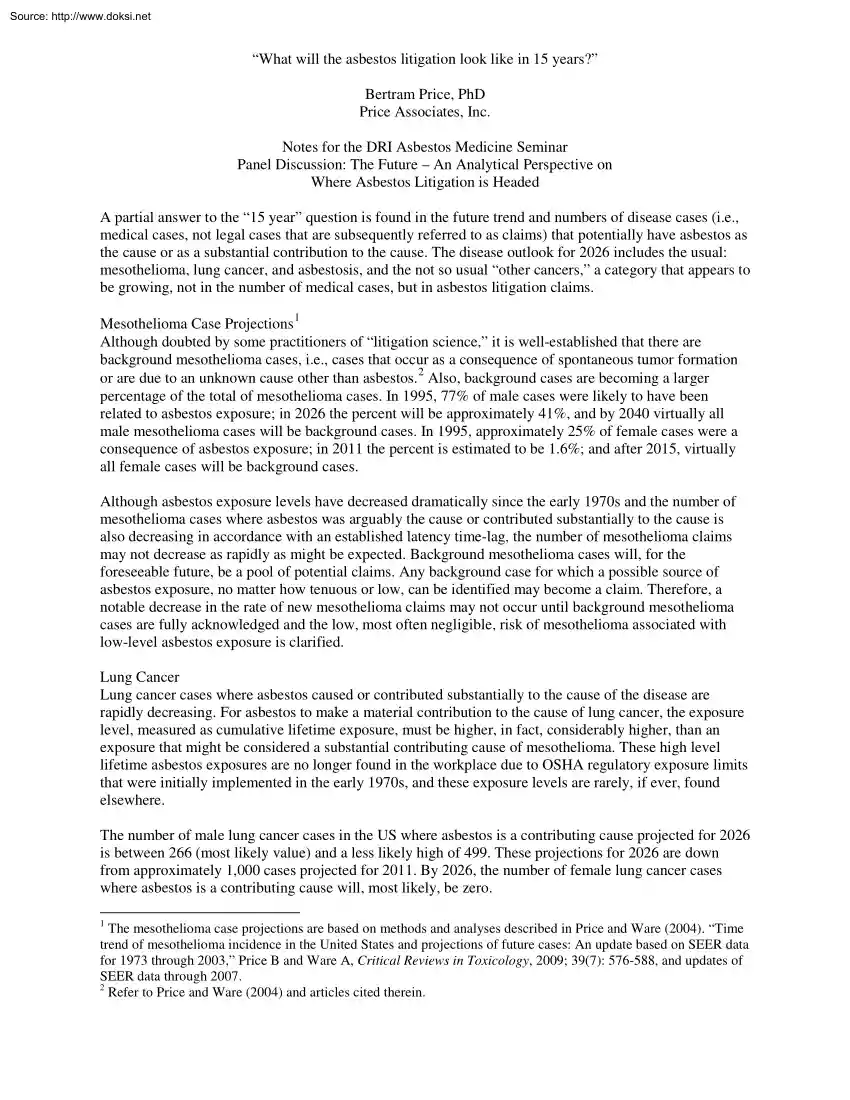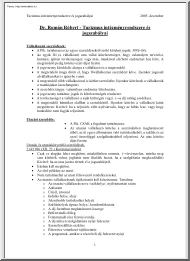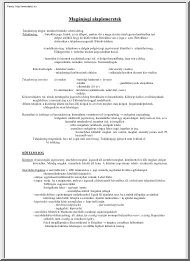Datasheet
Year, pagecount:2012, 3 page(s)
Language:English
Downloads:2
Uploaded:May 13, 2019
Size:466 KB
Institution:
-
Comments:
Attachment:-
Download in PDF:Please log in!
Comments
No comments yet. You can be the first!Most popular documents in this category
Content extract
Source: http://www.doksinet “What will the asbestos litigation look like in 15 years?” Bertram Price, PhD Price Associates, Inc. Notes for the DRI Asbestos Medicine Seminar Panel Discussion: The Future – An Analytical Perspective on Where Asbestos Litigation is Headed A partial answer to the “15 year” question is found in the future trend and numbers of disease cases (i.e, medical cases, not legal cases that are subsequently referred to as claims) that potentially have asbestos as the cause or as a substantial contribution to the cause. The disease outlook for 2026 includes the usual: mesothelioma, lung cancer, and asbestosis, and the not so usual “other cancers,” a category that appears to be growing, not in the number of medical cases, but in asbestos litigation claims. Mesothelioma Case Projections 1 Although doubted by some practitioners of “litigation science,” it is well-established that there are background mesothelioma cases, i.e, cases that occur as a
consequence of spontaneous tumor formation or are due to an unknown cause other than asbestos. 2 Also, background cases are becoming a larger percentage of the total of mesothelioma cases. In 1995, 77% of male cases were likely to have been related to asbestos exposure; in 2026 the percent will be approximately 41%, and by 2040 virtually all male mesothelioma cases will be background cases. In 1995, approximately 25% of female cases were a consequence of asbestos exposure; in 2011 the percent is estimated to be 1.6%; and after 2015, virtually all female cases will be background cases. Although asbestos exposure levels have decreased dramatically since the early 1970s and the number of mesothelioma cases where asbestos was arguably the cause or contributed substantially to the cause is also decreasing in accordance with an established latency time-lag, the number of mesothelioma claims may not decrease as rapidly as might be expected. Background mesothelioma cases will, for the
foreseeable future, be a pool of potential claims. Any background case for which a possible source of asbestos exposure, no matter how tenuous or low, can be identified may become a claim. Therefore, a notable decrease in the rate of new mesothelioma claims may not occur until background mesothelioma cases are fully acknowledged and the low, most often negligible, risk of mesothelioma associated with low-level asbestos exposure is clarified. Lung Cancer Lung cancer cases where asbestos caused or contributed substantially to the cause of the disease are rapidly decreasing. For asbestos to make a material contribution to the cause of lung cancer, the exposure level, measured as cumulative lifetime exposure, must be higher, in fact, considerably higher, than an exposure that might be considered a substantial contributing cause of mesothelioma. These high level lifetime asbestos exposures are no longer found in the workplace due to OSHA regulatory exposure limits that were initially
implemented in the early 1970s, and these exposure levels are rarely, if ever, found elsewhere. The number of male lung cancer cases in the US where asbestos is a contributing cause projected for 2026 is between 266 (most likely value) and a less likely high of 499. These projections for 2026 are down from approximately 1,000 cases projected for 2011. By 2026, the number of female lung cancer cases where asbestos is a contributing cause will, most likely, be zero. 1 The mesothelioma case projections are based on methods and analyses described in Price and Ware (2004). “Time trend of mesothelioma incidence in the United States and projections of future cases: An update based on SEER data for 1973 through 2003,” Price B and Ware A, Critical Reviews in Toxicology, 2009; 39(7): 576-588, and updates of SEER data through 2007. 2 Refer to Price and Ware (2004) and articles cited therein. Source: http://www.doksinet What will asbestos litigation look like in 15 years? Notes for DRI
Asbestos Medicine Seminar - November 2011 Page 2 of 3 Asbestosis Asbestosis generally requires even higher asbestos exposure levels than lung cancer. In 2026, the number of male asbestosis cases in the US will be so few they will be inconsequential, projected to be between 183 and 299. These projections for 2026 are down from approximately 900 male asbestosis cases projected for 2011. By 2026, the number of female asbestosis cases will be zero 3 Other Cancers Although the number of medical cases of cancer at sites belonging to the “other cancers” category is declining, there will continue to be sufficient numbers of individuals with cancers in this category to file claims where: (1) they believed that they were exposed to asbestos; and (2) they believed that asbestos caused or substantially contributed to the cause of their disease. The IOM report 4 released in 2006 concerning causal inference for pharyngeal, laryngeal, esophageal, and stomach cancer should have gone a long way
toward eliminating asbestos claims for all but laryngeal cancer. And, even for laryngeal cancer, it is clear from the studies reviewed by the IOM that low exposure levels of asbestos are not sufficient to cause or contribute substantially to the cause of the disease. In addition, studies published after the IOM report was released raise doubts about IOM’s causal finding for laryngeal cancer overall. Claims filed for “other cancers” have included cancers of the pharynx, larynx, esophagus, stomach, colon, throat, and tongue, multiple myeloma, and possibly other cancer types. Asbestos exposure levels for these claims are typically low with no epidemiological support that such a low-level asbestos exposure is capable of causing or substantially contributing to the cause of the disease. Unless the low exposure risk for these diseases is clearly delineated, the next 15 years is likely to include many claims for cases in the “other cancers” category that will be resolved with
settlement or damage award payments. Defense re Mesothelioma Claims 1. The defense must establish that mesothelioma cases not caused by asbestos are not rare, are less rare at this time among women than men, and are increasing (i.e, Mesothelioma =Asbestos Exposure is false) There are very few “confirmed” alternative causes of mesothelioma (eronite fibers, therapeutic radiation); therefore, the majority of mesotheliomas not caused by asbestos are background cases, i.e, occur as the consequence of spontaneous tumor formation or exposure to an unknown agent other than asbestos. Mesothelioma is not remarkable in this respect. Other than genetic/DNA factors, most cancers of public health concern have no known cause (breast, ovarian, prostate, pancreatic, colon, stomach, rectum); they occur as a consequence of spontaneous tumor formation. The proof that background mesothelioma cases exist in the US comes from two sources: (i) population studies where mesothelioma cases are counted,
asbestos exposure is assessed, and cases are found with little or no exposure; and (ii) trend analysis of mesothelioma incidence for women. 2. The defense must show that, whereas scientific/medical data are sufficient to support the conclusion that high asbestos exposure levels over extended periods can cause mesothelioma or may be a substantial contributing factor for mesothelioma, it does not follow that low level asbestos exposures also cause mesothelioma. Stated differently, scientific/medical data are not sufficient to support a conclusion that low-level asbestos exposure causes, or is a substantial contributing factor for, mesothelioma. 3 The projections were developed using a risk model for asbestosis developed by Price Associates, Inc. and historical asbestosis mortality counts through 2005; (http://www2.cdcgov/drds/WorldReportData/) 4 Asbestos: Selected Cancers http://www.napedu/catalog/11665html Source: http://www.doksinet What will asbestos litigation look like in 15
years? Notes for DRI Asbestos Medicine Seminar - November 2011 Page 3 of 3 The peer-reviewed literature on the types of low level asbestos exposures that cause or are substantial contributing factors for mesothelioma is extremely biased because of the wide-spread acceptance of “Mesothelioma=Asbestos Exposure.” The defense, through its experts, must dissect the studies used by the plaintiff in a specific case to expose the bias and put the causal argument in proper perspective. (As an example, through my work from a few years ago on “take-home exposure” I found that virtually every article about take-home exposure and mesothelioma begins with the assertion that a causal relationship exists and supports the assertion by citing one or more of three specific historical articles. I have dissected the three articles and found that by any reasonable standard for inferring causality, the data are not sufficient to support a causal conclusion between take-home exposure and
mesothelioma.) In general, the defense must be able to explain the flaws in studies that conclude that low level asbestos exposure causes or substantially contributes to the cause of mesothelioma. For example, the defense must be prepared to address the emerging group of studies on exposure to so-called “natural occurring asbestos,” population-based case-control studies, and review articles that accept, without critical analysis, the conclusions of previously published studies. One egregious example of the latter is “The health impact of non-occupational exposure to asbestos: what do we know” (Goldberg et al. in the European Journal of Cancer Prevention, 2009)
consequence of spontaneous tumor formation or are due to an unknown cause other than asbestos. 2 Also, background cases are becoming a larger percentage of the total of mesothelioma cases. In 1995, 77% of male cases were likely to have been related to asbestos exposure; in 2026 the percent will be approximately 41%, and by 2040 virtually all male mesothelioma cases will be background cases. In 1995, approximately 25% of female cases were a consequence of asbestos exposure; in 2011 the percent is estimated to be 1.6%; and after 2015, virtually all female cases will be background cases. Although asbestos exposure levels have decreased dramatically since the early 1970s and the number of mesothelioma cases where asbestos was arguably the cause or contributed substantially to the cause is also decreasing in accordance with an established latency time-lag, the number of mesothelioma claims may not decrease as rapidly as might be expected. Background mesothelioma cases will, for the
foreseeable future, be a pool of potential claims. Any background case for which a possible source of asbestos exposure, no matter how tenuous or low, can be identified may become a claim. Therefore, a notable decrease in the rate of new mesothelioma claims may not occur until background mesothelioma cases are fully acknowledged and the low, most often negligible, risk of mesothelioma associated with low-level asbestos exposure is clarified. Lung Cancer Lung cancer cases where asbestos caused or contributed substantially to the cause of the disease are rapidly decreasing. For asbestos to make a material contribution to the cause of lung cancer, the exposure level, measured as cumulative lifetime exposure, must be higher, in fact, considerably higher, than an exposure that might be considered a substantial contributing cause of mesothelioma. These high level lifetime asbestos exposures are no longer found in the workplace due to OSHA regulatory exposure limits that were initially
implemented in the early 1970s, and these exposure levels are rarely, if ever, found elsewhere. The number of male lung cancer cases in the US where asbestos is a contributing cause projected for 2026 is between 266 (most likely value) and a less likely high of 499. These projections for 2026 are down from approximately 1,000 cases projected for 2011. By 2026, the number of female lung cancer cases where asbestos is a contributing cause will, most likely, be zero. 1 The mesothelioma case projections are based on methods and analyses described in Price and Ware (2004). “Time trend of mesothelioma incidence in the United States and projections of future cases: An update based on SEER data for 1973 through 2003,” Price B and Ware A, Critical Reviews in Toxicology, 2009; 39(7): 576-588, and updates of SEER data through 2007. 2 Refer to Price and Ware (2004) and articles cited therein. Source: http://www.doksinet What will asbestos litigation look like in 15 years? Notes for DRI
Asbestos Medicine Seminar - November 2011 Page 2 of 3 Asbestosis Asbestosis generally requires even higher asbestos exposure levels than lung cancer. In 2026, the number of male asbestosis cases in the US will be so few they will be inconsequential, projected to be between 183 and 299. These projections for 2026 are down from approximately 900 male asbestosis cases projected for 2011. By 2026, the number of female asbestosis cases will be zero 3 Other Cancers Although the number of medical cases of cancer at sites belonging to the “other cancers” category is declining, there will continue to be sufficient numbers of individuals with cancers in this category to file claims where: (1) they believed that they were exposed to asbestos; and (2) they believed that asbestos caused or substantially contributed to the cause of their disease. The IOM report 4 released in 2006 concerning causal inference for pharyngeal, laryngeal, esophageal, and stomach cancer should have gone a long way
toward eliminating asbestos claims for all but laryngeal cancer. And, even for laryngeal cancer, it is clear from the studies reviewed by the IOM that low exposure levels of asbestos are not sufficient to cause or contribute substantially to the cause of the disease. In addition, studies published after the IOM report was released raise doubts about IOM’s causal finding for laryngeal cancer overall. Claims filed for “other cancers” have included cancers of the pharynx, larynx, esophagus, stomach, colon, throat, and tongue, multiple myeloma, and possibly other cancer types. Asbestos exposure levels for these claims are typically low with no epidemiological support that such a low-level asbestos exposure is capable of causing or substantially contributing to the cause of the disease. Unless the low exposure risk for these diseases is clearly delineated, the next 15 years is likely to include many claims for cases in the “other cancers” category that will be resolved with
settlement or damage award payments. Defense re Mesothelioma Claims 1. The defense must establish that mesothelioma cases not caused by asbestos are not rare, are less rare at this time among women than men, and are increasing (i.e, Mesothelioma =Asbestos Exposure is false) There are very few “confirmed” alternative causes of mesothelioma (eronite fibers, therapeutic radiation); therefore, the majority of mesotheliomas not caused by asbestos are background cases, i.e, occur as the consequence of spontaneous tumor formation or exposure to an unknown agent other than asbestos. Mesothelioma is not remarkable in this respect. Other than genetic/DNA factors, most cancers of public health concern have no known cause (breast, ovarian, prostate, pancreatic, colon, stomach, rectum); they occur as a consequence of spontaneous tumor formation. The proof that background mesothelioma cases exist in the US comes from two sources: (i) population studies where mesothelioma cases are counted,
asbestos exposure is assessed, and cases are found with little or no exposure; and (ii) trend analysis of mesothelioma incidence for women. 2. The defense must show that, whereas scientific/medical data are sufficient to support the conclusion that high asbestos exposure levels over extended periods can cause mesothelioma or may be a substantial contributing factor for mesothelioma, it does not follow that low level asbestos exposures also cause mesothelioma. Stated differently, scientific/medical data are not sufficient to support a conclusion that low-level asbestos exposure causes, or is a substantial contributing factor for, mesothelioma. 3 The projections were developed using a risk model for asbestosis developed by Price Associates, Inc. and historical asbestosis mortality counts through 2005; (http://www2.cdcgov/drds/WorldReportData/) 4 Asbestos: Selected Cancers http://www.napedu/catalog/11665html Source: http://www.doksinet What will asbestos litigation look like in 15
years? Notes for DRI Asbestos Medicine Seminar - November 2011 Page 3 of 3 The peer-reviewed literature on the types of low level asbestos exposures that cause or are substantial contributing factors for mesothelioma is extremely biased because of the wide-spread acceptance of “Mesothelioma=Asbestos Exposure.” The defense, through its experts, must dissect the studies used by the plaintiff in a specific case to expose the bias and put the causal argument in proper perspective. (As an example, through my work from a few years ago on “take-home exposure” I found that virtually every article about take-home exposure and mesothelioma begins with the assertion that a causal relationship exists and supports the assertion by citing one or more of three specific historical articles. I have dissected the three articles and found that by any reasonable standard for inferring causality, the data are not sufficient to support a causal conclusion between take-home exposure and
mesothelioma.) In general, the defense must be able to explain the flaws in studies that conclude that low level asbestos exposure causes or substantially contributes to the cause of mesothelioma. For example, the defense must be prepared to address the emerging group of studies on exposure to so-called “natural occurring asbestos,” population-based case-control studies, and review articles that accept, without critical analysis, the conclusions of previously published studies. One egregious example of the latter is “The health impact of non-occupational exposure to asbestos: what do we know” (Goldberg et al. in the European Journal of Cancer Prevention, 2009)





